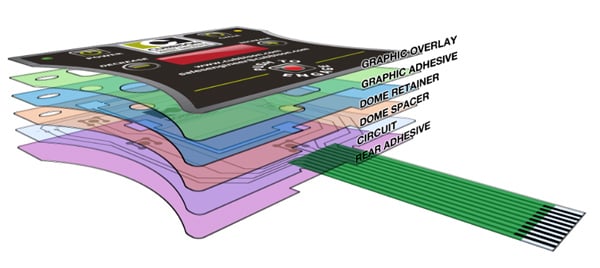Membrane Switches: A Key Component in Bespoke Control Panels
Wiki Article
Membrane Switch Technology: The Trick to Reliable and Affordable Interfaces
Membrane layer switch technology has emerged as a crucial element in the style of user interfaces, offering both dependability and cost-effectiveness across a varied array of applications. As we explore the diverse advantages of membrane layer buttons, their potential for technology raises inquiries regarding future applications and evolving patterns.Recognizing Membrane Switch Over Innovation
Membrane button technology is a widely used user interface service in numerous electronic devices, providing a smooth mix of capability and layout. This modern technology incorporates multiple layers of materials, typically being composed of a visuals overlay, spacer layer, and a circuit layer. The graphic overlay displays the user interface components, while the spacer layer separates the circuit layer from the overlay up until a user triggers a button.When stress is used to the overlay, the circuit layer completes the electrical circuit, sending out a signal to the gadget. This system enables numerous setups, consisting of responsive responses and backlighting options, boosting user interaction. Membrane switches are usually made utilizing resilient products such as polyester or polycarbonate, ensuring longevity and resistance to ecological aspects like wetness and dust.
The convenience of membrane layer switches over allows their application in varied sectors, including medical gadgets, consumer electronics, and commercial controls. Their compact design enables for assimilation right into space-constrained settings, giving an effective customer interface without endangering aesthetic charm. Recognizing the complexities of membrane button modern technology is necessary for producers and designers seeking to develop trusted and efficient human-machine user interfaces.
Secret Benefits of Membrane Layer Switches
While numerous interface options exist, membrane switches over offer distinctive advantages that make them a preferred option in various applications. Among the key advantages is their durability; membrane switches are made to endure severe ecological conditions, consisting of moisture, dust, and temperature fluctuations, ensuring long-lasting performance. This durability considerably lowers the need for constant replacements, consequently decreasing general maintenance prices.
Moreover, membrane buttons are light-weight and small, making them appropriate for applications where area is limited. Their low-profile design adds to a sleek look without endangering performance.
Cost-effectiveness is additionally a noteworthy benefit, as the production process for membrane changes has a tendency to be less expensive contrasted to traditional mechanical buttons. This affordability, combined with their integrity and convenience of installation, settings membrane switches as a functional remedy for a large range of industries looking for reliable and reliable interface.
Applications Across Different Industries
How do membrane switches adapt to the varied demands of various sectors? Membrane button technology is increasingly recognized for its flexibility, making it ideal for a vast variety of applications across numerous industries.In customer electronics, membrane switches give a portable option for push-button controls and home appliances, boosting user experience through instinctive design. Furthermore, the industrial field leverages membrane switches for machinery control board, gaining from their resistance to rough atmospheres, such as wetness and dirt.
Armed forces and aerospace applications additionally utilize membrane layer buttons for their you could look here dependability and capability to withstand severe conditions, guaranteeing operational performance in critical circumstances. In addition, the food and beverage industry takes on these buttons for automated systems, where sanitation and ease of procedure are paramount. Ultimately, membrane buttons are tailored to fulfill the one-of-a-kind needs of each industry, proving their vital role in contemporary technology interfaces
Design and Personalization Alternatives

In the realm of membrane layer button modern technology, layout and modification choices play a pivotal duty in improving performance and customer communication. These switches can be tailored to satisfy details functional demands and aesthetic preferences, making them flexible elements in various applications.
One of the key modification alternatives is the format of the switch itself, which can be designed to suit unique individual interfaces and ergonomic factors to consider. By readjusting the form, size, and setup of buttons, manufacturers can produce intuitive designs that promote ease of use. Additionally, the unification of different colors and visuals overlays enables for branding and boosted presence, making certain that individuals can view quickly determine functions.
Additionally, membrane layer buttons can be crafted with different tactile responses devices, such as why not look here elevated buttons or distinct clicks, to improve the individual experience. Different products can also be chosen for toughness and ecological resistance, resolving variables such as dampness, temperature variations, and chemical direct exposure.
Inevitably, the considerable layout and modification options available in membrane layer button modern technology equip organizations to produce tailored services that not only meet practical demands yet likewise align with their branding and operational requirements.

Future Trends in Membrane Switches
As membrane layer button innovation remains to progress, future trends are progressively concentrated on boosting customer experience and integrating innovative performances. One substantial pattern is the assimilation of touch-sensitive and capacitive technologies right into conventional membrane buttons. This advancement allows for even more instinctive interface, offering tactile responses while preserving a smooth design.One more arising trend is making use of ecologically pleasant products, driven by the expanding need for lasting manufacturing techniques. Producers are looking for to lower their carbon footprint by making use of recyclable substrates and low-impact inks, straightening with international sustainability goals.
Moreover, the rise of the Web of Things (IoT) is triggering the unification of clever attributes into membrane layer buttons. Boosted connectivity options will enable gadgets to connect with each various other, enabling smooth assimilation right into wider systems.
Furthermore, innovations in printing modern technologies, such as electronic printing, are permitting better style adaptability and customization. This allows suppliers to create intricate designs and vivid colors cost-effectively.

Final Thought
In conclusion, membrane layer switch modern technology represents a crucial technology in user interface design, using substantial advantages in durability, customization, and cost-effectiveness. As improvements continue to arise, particularly in touch-sensitive user interfaces and sustainable materials, the potential for membrane changes to improve customer experience and functionality continues to be promising.Report this wiki page